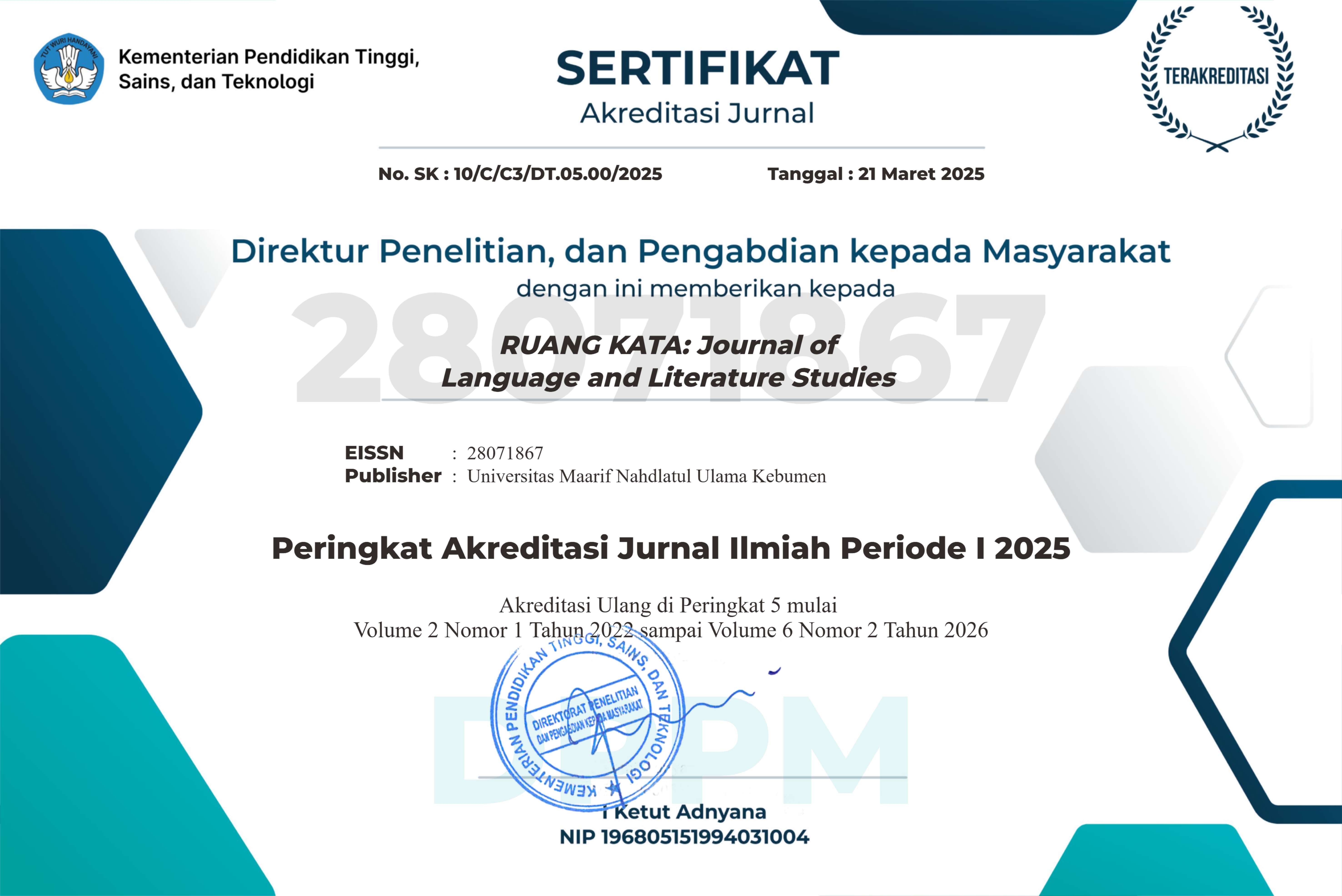Lima Kode Roland Barthes dalam Cerpen Jangan Kau Beli Rumah Itu Karya K. Usman
DOI:
https://doi.org/10.53863/jrk.v5i02.1703Keywords:
Semiotics, Five Codes; Mandate; Roland Barthes, Short StoryAbstract
This study aims to present the mode of transactional messages contained in the short story Jangan Kau Beli Rumah Itu (Don’t Buy That House) by K. Usman. The research method used in this study is descriptive qualitative research. Data collection was carried out through literature review techniques, namely observation and note-taking. Data analysis was conducted using the five codes proposed by Roland Barthes. The research findings yielded a total of nineteen data points. Four data points related to the hermeneutic code reveal the mysterious presence of the character Gurun, whose identity remains unknown and whose absence during congregational prayers at the mosque is perceived as unusual by the worshippers. Three data points related to the connotative code illustrate figurative expressions reflecting the absence of Gurun, the congregation's boredom due to repetitive and uninspiring sermons, and a metaphor suggesting that preachers should study harder from various teachers and sources. Three data points concerning the symbolic code indicate the presence of three symbols: statues or monuments representing individuals who refuse to learn and thus possess stagnant knowledge; full-grown rice grains symbolizing humility; and evening time representing old age. Seven data points related to the action code highlight active actions performed by characters in the short story. Two data points related to the cultural code refer to the respect a son-in-law shows to his in-laws and to Gurun's religious knowledge and steadfast faith. The main message conveyed in the story emphasizes the importance of preserving one's faith
References
Astarini, K. D., Katrini, Y. E., & Ekawati, M. (2018). Kajian Semiotika Roland Barthes Dalam Antologi Cerpen Sepotong Senja Untuk Pacarku Karya Seno Gumira Ajidarma Dan Formulasi Bahan Ajarnya Di SMA. Riset Pendidikan Bahasa Dan Sastra Indonesia, 1(1), 68–77. http://jom.untidar.ac.id/index.php/repetisi/68
Barthes, R. (2002). S/Z. Blackwell Publishing Ltd.
Fiantika, F. R. dkk. (2020). Metodologi Penelitian Kualitatif. In Metodologi Penelitian Kualitatif. In PT Global Eksekutif Teknologi (Issue March). PT Global Eksekutif Teknologi. https://scholar.google.com/citations?user=O-B3eJYAAAAJ&hl=en
Lestary, A. D., Warni, & Wulandari, S. (2022). Kode-Kode Narasi Semiotika Roland Barthes dalam Novel dari Jendela SMP Karya Mira Widjaja. Kajian Linguistik Dan Sastra, 1(1), 1–8. https://doi.org/10.22437/kalistra.v1i1.18421
Marwata, H. (2000). Roland Barthes Lewat S/Z: Mencerna Cerita Via Leksia. In Humaniora (Vol. 12, Issue 1, pp. 47–58).
Monanda, D., & Wilyanti, L. S. (2023). Kajian Semiotika Roland Barthes Pada Cerpen Tamu Karya Budi Darma. Aksara: Jurnal Ilmiah Pendidikan Bahasa Dan Sastra Indonesia, 7(1), 44. https://doi.org/10.33087/aksara.v7i1.491
Ramadhani, A., & Suryaman, M. (2024). Sistem Kode Roland Barthes dalam Cerpen Emak Karya Fakhrunnas M.A.Jabbar. Ruang Kata: Journal of Language an Literature Studies, 4(02), 83–91.
Ratih, R. (2016). Semiotik Michael Riffaterre: Teori dan Aplikasi. Yogyakarta: Pustaka Pelajar.
Saifudin, A., & Noviana, F. (2023). Analisis Semiologi Roland Barthes pada Teks Lirik Lagu Nanatsu no Ko Karya Noguchi Ujo. Izumi, 12(2), 109–122. https://doi.org/10.14710/izumi.12.2.109-122
Santosa, P. (2013). Ancangan Semiotika dan Pengkajian Susastra. Bandung: Penerbit Angkasa.
Usman K. (2004). Menari di Atas Air. Bestari.
Downloads
Published
How to Cite
License
Copyright (c) 2025 Jumianti Diana

This work is licensed under a Creative Commons Attribution-ShareAlike 4.0 International License.
Authors retain copyright and grant the journal right of first publication with the work simultaneously licensed under a Creative Commons Attribution-ShareAlike 4.0 International License that allows others to share the work with an acknowledgment of the work’s authorship and initial publication in this journal














